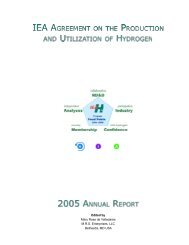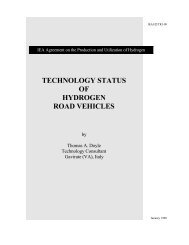Review of Small Stationary Reformers for Hydrogen Production
Review of Small Stationary Reformers for Hydrogen Production
Review of Small Stationary Reformers for Hydrogen Production
Create successful ePaper yourself
Turn your PDF publications into a flip-book with our unique Google optimized e-Paper software.
EXECUTIVE SUMMARY<br />
Approximately 95% <strong>of</strong> the hydrogen produced today comes from carbonaceous raw material,<br />
primarily fossil in origin. Only a fraction <strong>of</strong> this hydrogen is currently used <strong>for</strong> energy purposes;<br />
the bulk serves as a chemical feedstock <strong>for</strong> petrochemical, food, electronics and metallurgical<br />
processing industries. However, hydrogen’s share in the energy market is increasing with the<br />
implementation <strong>of</strong> fuel cell systems and the growing demand <strong>for</strong> zero-emission fuels. <strong>Hydrogen</strong><br />
production will need to keep pace with this growing market.<br />
In the near term, increased production will likely be met by conventional technologies, such as<br />
natural gas re<strong>for</strong>ming. In these processes, the carbon is converted to CO2 and released to the<br />
atmosphere. However, with the growing concern about global climate change, alternatives to<br />
the atmospheric release <strong>of</strong> CO2 are being investigated. Sequestration <strong>of</strong> the CO2 is an option<br />
that could provide a viable near-term solution.<br />
Cost <strong>of</strong> building sufficient distribution infrastructure and transporting hydrogen over large<br />
distances are major economic barriers to the implementation <strong>of</strong> hydrogen-based technologies,<br />
particularly in the transportation sector. Additionally, large-scale central production will depend<br />
on market volumes to evolve in order to compensate <strong>for</strong> the capital expenditures <strong>of</strong> building up<br />
capacity. Thus, distributed production via smaller re<strong>for</strong>mer systems is viewed as an attractive<br />
near- to mid-term option <strong>for</strong> supplying hydrogen, particularly <strong>for</strong> vehicles and in regions where<br />
low-cost natural gas is readily available, and <strong>for</strong> securing market share <strong>for</strong> hydrogen<br />
technologies.<br />
Re<strong>for</strong>mer technology is commercially available today. However, scale economies in capital cost<br />
can be significant. Lower pressure and temperature and lower cost materials are needed to<br />
make small-scale, distributed re<strong>for</strong>ming competitive. Minimizing CO2 emissions must also be<br />
addressed, as carbon capture and sequestration will be too costly at the small scale.<br />
Recently, the International Energy Agency’s (IEA) Program on the <strong>Production</strong> and Utilization <strong>of</strong><br />
<strong>Hydrogen</strong> launched its new Task 16, <strong>Hydrogen</strong> from Carbon-Containing Materials, to bring<br />
together international experts to investigate some <strong>of</strong> these near- and mid-term options <strong>for</strong><br />
producing hydrogen with reduced environmental impacts. In addition to large-scale fossil-based<br />
production with carbon sequestration, small-scale re<strong>for</strong>ming <strong>for</strong> distributed generation and<br />
technologies to convert biomass to hydrogen are included in the activity.<br />
This review <strong>of</strong> current hydrogen production technologies was prepared to facilitate in the<br />
planning <strong>of</strong> collaborative activities to be carried out under the auspices <strong>of</strong> the IEA and focusing<br />
on advancing small-scale re<strong>for</strong>mers <strong>for</strong> distributed hydrogen production. This report surveys<br />
conventional technologies:<br />
• Steam Methane Re<strong>for</strong>ming<br />
• Partial Oxidation<br />
• Auto-Thermal Re<strong>for</strong>ming<br />
• Methanol Re<strong>for</strong>ming<br />
• Catalytic Cracking <strong>of</strong> Methane<br />
• Ammonia Cracking<br />
Novel re<strong>for</strong>mer technologies, such as sorbent enhanced re<strong>for</strong>ming, ion transport re<strong>for</strong>ming,<br />
plasma re<strong>for</strong>ming and microchannel re<strong>for</strong>ming are also discussed. Technologies are reviewed













